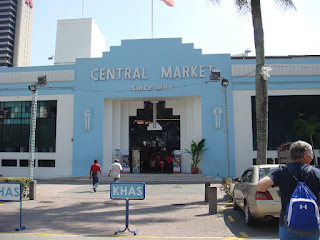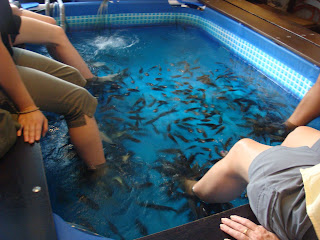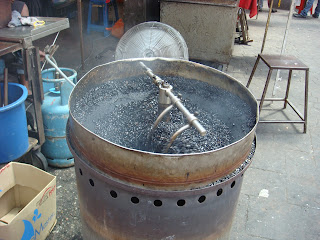Arrived bright and early this morning in Port Klang – an
Island port, off the coast of the Malay peninsula, in the Straits of Malacca.
This is the main port for Kuala Lumpur and was expected to be a major area for
future growth and development but instead all the residential buildings and
commercial sites are run down and either empty or in very sad occupied shape.
Nothing really to do in Port Klang or Klang City so the
attraction is Kuala Lumpur – which is a major commercial city bustling and
ever-enlarging.
The trip to KL requires a bus ride and there were 9 busloads
who were on our trip. Its remarkable how much angst lining up and getting on
board the bus causes. Its almost a full contact sport involving elbows and
heavy luggage.
It’s a 90 minute drive from the port to KL so Deanna our
guide had plenty of time to tell us the history and demography.
It turns out that the coastal region of Malaysia has a long
and sad colonial history – first the Portuguese, then the Dutch and the British
– each for over 100 years – then the Japanese for 31/2 years and finally
independence in the 1960s after a Communist uprising and war.
Along the way the Malay majority has melded with a Chinese
population (that arrived primarily to work on the tin mines) and an Indian
minority that the British brought in to work on the rubber and palm oil
plantations.
We had selected to spend the day in KL on our own – meaning
we had no plans for sightseeing but rather were going to spend our time
downtown mooching around and shopping – I did the mooching and Merle did the
shopping. I also caught up on internet – messages (few), finances (diminishing)
and blogging.
The place we always start in KL is at the big shopping mall
associated with the Petronas Twin Towers. There are a few important attractions
here – Kinokuniya – the amazing Japanese bookstore is the main one – for coffee
(me), wireless access (me) and magazines (not me).
I got the appropriate first-thing in the morning 10am
welcome from the staff when we arrived.
Then we caught the light rail to go to the Central Market
and Chinatown – getting around here is extremely easy – English is a second
language and everything is clearly labeled!
The Central Market was once the “wet market” for the tin
miners but now offers shopping as the main attraction.
At first, the watch
stores amaze and (possibly excite) with their variety and multiplicity; as do
the handbag and wallet stores, the t-shirt stores and the tzatchke palaces.
However, the joy is shortlived in mudville because there is absolutely no end
to the number of repetitions of the above.
Chinatown, specifically Petalling Street, has more of the
same to the point that eventually the intrepid traveller has to focus on the
more unusual in the attractive line – the lovely flowers
Or the more bizarre line, like the fish that massage your
feet, eat the dead skin and generally restore health and vitality
Or the multitude of “zoological specimens’ on
sale – including birds of great variety, rabbits and puppies whose fate I would
only want to lightly skim over
finally, came across this store roasting (in this case coffee beans) or chestnuts or whatever. the look of the coffee made me thirsty so off I go looking for a Starbucks.
Brandname stores are now global. KFC is in Chinatown; as is McDonalds (where do you think the puppies go?) but what amazes and impresses me is that Nando's is now a 'global Brand' - thats Nandos from little bitty CapeTown I believe. must have made a $ or two huh?


























































